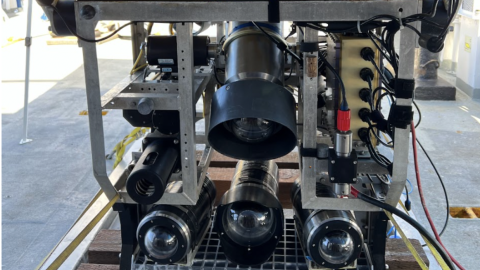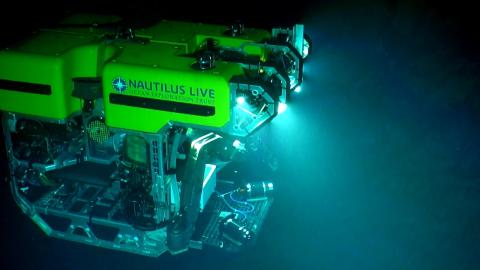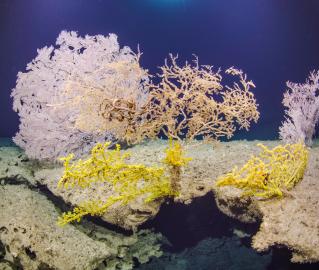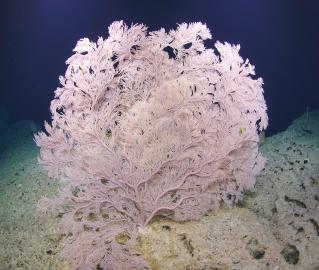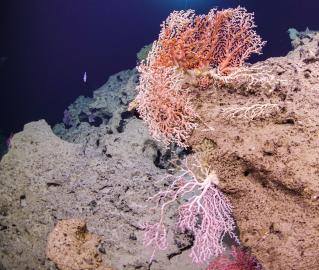The Deep Dark Truth About Corals
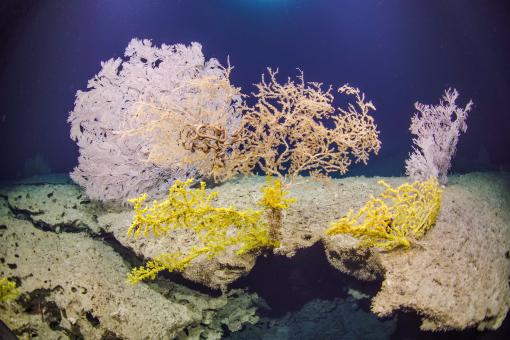
This blog was written by Science Communication Fellow Daniella Griffay, a marine science teacher at Radford High School in Honolulu, Hawai’i.
When you think of Hawaii, images of beautiful white sand beaches and snorkeling in crystal blue waters filled with vibrantly hued coral reefs and thousands of fish might come to mind. By most, such corals are often thought to be shallow-water species, however, these are very different from the deep-water species that the Ocean Exploration Trust Corps of Exploration is interested in understanding.
Characteristics of shallow-water coral support a life dependent on sun
The most familiar type of coral found within primary reef-building corals are also known as scleractinian, or hard corals. Hard corals produce a calcium carbonate exoskeleton and are composed of thousands of individual polyps. Polyps are tiny animals that live individually or as a colony and have a ring of tentacles surrounding a mouth. The tentacles have stinging cells called nematocysts (same as sea anemones and jellyfish) that are used to capture prey of small animal plankton called zooplankton.
For example, shallow-water coral species that are prominent in Hawaii include:
- Lobe corals
- Hawaiian name: Pāhaku Puna
- Scientific name: Porites lobata
- Rice coral
- Hawaiian name: Ko’a
- Scientific name: Montipora capitata
- Cauliflower coral
- Hawaiian name Ko’a
- Scientific name: Pocillopora meandrina
Corals are related to jellyfish and are in the same phylum Cnidarians. These corals have a symbiotic relationship with photosynthetic algae called zooxanthellae. Zooxanthellae are what give corals their beautiful color due to their pigment used to capture light for photosynthesis, which then take the energy from sunlight to make food for the corals. During the day coral will have a more hard rock looking surface because their polyps are hiding within the calcium carbonate skeleton so as not to be eaten and the coral is using its zooxanthellae to make food. At night the coral will look fuzzy as it has all of its polyps out to feed. Scleractinian are found only in the epipelagic zone (or sunlight zone), which is 0-200 m (650 feet).
Deep-water corals can thrive without light
Explorations conducted by E/V Nautilus focus primarily on deep-water organisms, coral among them.
One such species includes black corals (family Antipathidae), which are Hawaii’s state gem! The Hawaiian name for this is ʻEkaha kū moana and is often used for jewelry. Black coral is not only black but can be a range of colors and shapes and their polyps secrete a protein skeleton. There are 14 known species of black coral in Hawaii.
According to NOAA, deep-sea corals can live at depths of over 3,000 meters, dealing with extreme pressures and little to no light. Deep-water corals do not have zooxanthellae, which means they don’t need sunlight, and lack the calcium carbonate exoskeleton. Rather, corals found at extreme depths have spicules which are small spikes made up of calcium carbonate to give the coral structure.
Deep-water corals are typically found in fan, feather, and whip-like shapes that can reach dozens of feet tall into the water column, allowing them to feed on microscopic organisms drifting through the water column. Deep-sea corals commonly form symbiotic relationships with many fish, crabs, and other creatures (which we call associates) that use these corals for habitat.
Nautilus explores deep-water coral garden
During NA156 Ocean Exploration through Advanced Imaging, E/V Nautilus visited Keahole Point Precious Coral Bed, located off Keahole Point on the Kona Coast, where scientists explored a region home to an abundant and diverse coral population.
To better understand coral species in the area, we deployed a new imaging technology known as the Widefield Camera Array System, which allowed for the creation of 3D models resembling these beautiful coral beds.
Such models will be used to manage and study corals at this location and beyond, allowing for further comparisons determining how populations change and evolve over time. For example, a previous dive conducted in the region by the Hawaiian University Research Lab (HURL) built upon a previous 1975 exploration to determine that the coral bed was four times larger than initially believed. This increase, it is thought, was largely due to technological advances that allowed scientists to further explore the area in greater detail.
Likewise, our survey will further expand our knowledge and understanding of the planet’s deepest ecosystems.
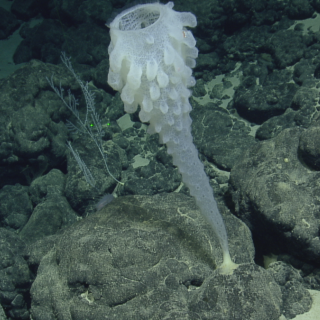
Ocean Exploration through Advanced Imaging
In October, we return to ROV dives continuing our work to advance technology use in the deep sea. Experimenting with deploying a new camera technology, we will explore using a new wide-field camera array on ROV Hercules to capture three-dimensional stereoscopic imagery from the seabed.
